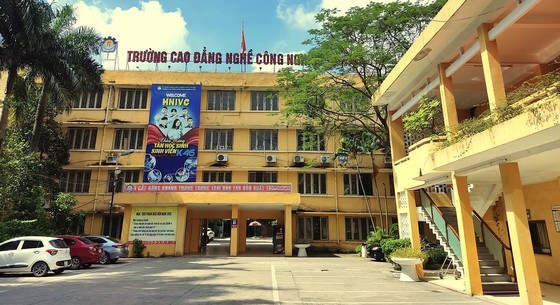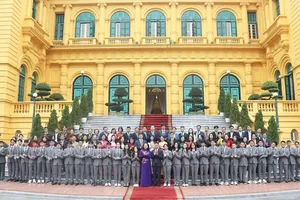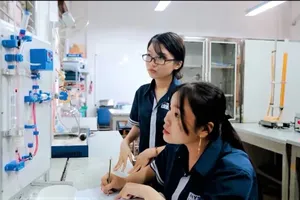 |
The 49-year-old Hanoi Industrial Vocational College (Thai Thinh Ward, Dong Da, Hanoi). |
In response to the crisis facing vocational schools, at the last National Assembly session, Minister of Labor, Invalids and Social Affairs Dao Ngoc Dung acknowledged the existing limitations and affirmed that the industry is drastically restructuring the system, avoiding duplication to yield efficiency. The Ministry of Labor, Invalids and Social Affairs, and 63 provinces are reviewing and arranging to re-plan vocational education institutions in a synchronous and modern direction; ensuring proper quality in terms of industry, profession training, and regional distribution.
Two-year salaries unpaid
The Central and Northern regions feature both well-invested and modern vocational schools and dilapidating ones. For example, Nam Dinh Textile and Apparel Industry College (No. 6, Hoang Dieu Street, Nang Tinh Ward, Nam Dinh City) is a public institution under the Vietnam National Textile and Garment Group (Vinatex), but due to the lack of a governing body in the last 8 years, they have to pay for their own salaries and operating expenses.
Five out of six faculties in the school are almost "obliterated" because they failed to enroll students, except the Faculty of Sewing and Fashion, whose teaching staff had to enroll each student. In the enrollment season in 2022, the school only managed to recruit one garment class with 13 students, lifting the total number of students studying officially at the school to 140 people and at affiliated units to 2,077 students, compared to the number of 106 officers, teachers, and employees in the school (there were about 400 officers, teachers, and staff during the school's golden age). The school has not paid salaries for the past two years and has not paid social insurance contributions for the past 40 months.
According to Mr. Nguyen Khac Tuat, Rector of Nam Dinh Textile and Garment Industry College, there were times when the school attracted 3,000 students per year, and the number of students for the textile industry reached 7,000. It used to be awarded the third and second-class Labor Medals by the State for quality training and facilities, yet now fell into a miserable situation. As the holding company, Vinatex has been equitized, now the school has been rendered obsolete, receiving the management of neither the Vinatex enterprise nor Nam Dinh Province.
In Hanoi, a number of colleges and intermediate schools are also facing seriously degraded facilities without proper refurbishment. In 2018, the Hanoi People's Committee issued Decision 3034/QD-UBND approving the proposal for a new construction investment project of Hanoi Industrial Vocational College (HNIVC) in Nguyen Khe Commune, Dong Anh District in the form BT (build and transfer), carried out on an area of nearly 9 hectares, including 5 five-story blocks, with the total investment of US$37.8 million (VND894 billion).
The investors shall be granted the right to purchase land at 131 Thai Thinh, Dong Da District, which is HNIVC's 49-year-old premises with an area of 24,000 square meters. Afterward, the Ministry of Finance issued a document guiding the implementation. However, the implementation has been paused, hence the suspension of the HNIVC new construction project.
Student Nguyen Minh Duc (20 years old, from Nam Dinh), College of Automation - K.45 also expressed disappointment at the mismatch between the poor facilities and the school's high reputation, hoping HNIVC to be invested for reconstruction.
Unequal distribution
In 2023, the Ministry of Labor, Invalids and Social Affairs planned to reduce 279 technical and vocational education and training (TVET) institutions; now there are 1,888 institutions nationwide. Most localities have only one to two TVET institutions left. The country starts to form a network of high-quality schools and national, regional, and international key occupations based on each TVET institution, region, locality, and training level.
Despite the initial developments, the network of vocational institutions is still not properly distributed, mainly concentrated in urban areas. The planning of the network of TVET institutions also lacks a link with the planning of human resource development, sectors, and localities, or the training level.
In particular, in the Red River Delta and the Southeast, the number of TVET institutions is 570 schools and and 279 schools, accounting for 30 percent and 15.6 percent respectively, compared to the whole country. In recent years, the number of enrollments in these two regions averaged 700,000 and 480,000 respectively, accounting for 55 percent of the total enrollment of the country.
Meanwhile, there are 412 schools in the North Central and Central Coast regions, 280 in the Northern Midlands and Mountains, 30 in the Mekong Delta, and 98 in the Central Highlands with low training quality and low enrollment, accounting for over 55.4 percent
Dr. Truong Anh Dung, Director General of the General Department of Vocational Education and Training, assumed that these are the problems that must be rearranged and re-planned. For example, the number of vocational institutions in the Red River Delta region decreased from 30 percent to 26 percent while the figure in the Southeast is to increase from 15.6 percent to 17 percent.
The highlight is that the planning and rearrangement of TVET institutions across the country will contribute to upgrading a number of national or regional centers for quality vocational training and practice. These centers can provide training and practice for new skills in TVET programs, and at the same time provide training and retraining to improve qualifications, skills, and new technologies for the TVET teaching staff.
Regarding the planning of TVET institutions in Da Nang City, Deputy Director of Da Nang Department of Labor, Invalids and Social Affairs Le Van Minh revealed that the city is merging the overlapping vocational training professions in intermediate schools into college, and dissolving ineffective intermediate schools and colleges. By 2025, there will only be 69 TVET institutions in Da Nang City, including 20 colleges, 5 intermediate schools, 44 vocational training centers, and other establishments.
Moreover, the city will establish 7 TVET institutions in accordance with the standards of quality accreditation of TVET institutions in the country. By 2030, 4 TVET institutions of regional and international levels will be formed, including Da Nang Vocational College, Tourism College, Central College of Transport V, and College of Commerce. Da Nang City develops new TVET institutions according to the labor supply and demand of a number of key economic sectors, avoiding duplication and overlapping that may affect enrollment and job creation after graduation. Besides, priority will be placed on the investment in new TVET institutions outside the city center such as Hoa Vang, Ngu Hanh Son, Cam Le, and Lien Chieu districts.
Da Nang City has transferred Da Nang Vocational College to the Ministry of Labor, Invalids and Social Affairs for management to focus on investment and reorganize it into a National Center for High-Quality Training and Practice in the Central region. Previously, the People's Committee of Da Nang City approved the project of Da Nang Vocational College to become a high-quality school and the investment project of key occupations with a total investment of nearly $24.7 million (VND584 billion). Da Nang Vocational College has completed project reports and submitted to competent authorities for approval of investment policies for component projects, said Mr. Le Van Minh.
Implementing Decision 73 on approving the master plan on the network of TVET institutions for the period of 2021-2030, with a vision to 2045, issued by the Government, the General Department of Vocational Education and Training continues to coordinate with 63 provinces and cities, especially the system of TVET institutions under ministries and agencies to develop the network of vocational schools in a synchronous and modern direction.
That move aims at ensuring the development in terms of scale, structure, and proper training for different professions and levels (multi-disciplinary, specialized), with regional, standardized, modernized, and quality-stratified development.
Dr. Truong Anh Dung, Director General of the General Department of Vocational Education and Training
HCMC merged about 80 percent of middle schools into colleges According to Deputy Director of the Ho Chi Minh City Department of Labor, Invalids and Social Affairs Nguyen Van Lam since 2008, the city has implemented phase 1 of building a scheme to re-plan the network of vocational schools in a streamlined and efficient manner. Up to now, the number of TVET institutions has been reduced from 517 institutions in 2015 to 370.
Implementing Decision 73, the HCMC Department of Labor, Invalids and Social Affairs has assigned working delegations to each district and Thu Duc city to survey as well as work with localities, and then develop an implementation plan based on the Government's planning and the general planning of the city.
By 2025, HCMC will have merged at least 50 percent of intermediate schools into colleges or merged inefficient colleges into effective ones. By 2030, at least 80 percent of intermediate schools will have been merged into colleges.
























